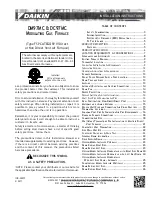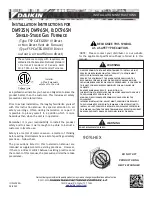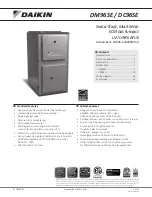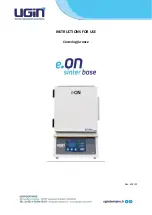
F96CTN and G96CTN (Series A): Installation, Start-up, Operating, Service and Maintenance Instructions
Manufacturer reserves the right to change, at any time, specifications and designs without notice and without obligations.
18
Supply Air Connections
For a furnace not equipped with a cooling coil, the outlet duct shall be
provided with a removable access panel. This opening shall be
accessible when the furnace is installed and shall be of such a size that
the heat exchanger can be viewed for possible openings using light
assistance or a probe can be inserted for sampling the air stream. The
cover attachment shall prevent leaks.
Connect supply-air duct to flanges on furnace supply-air outlet. Bend
flange upward to 90° with wide duct pliers. See
. The supply-air
duct must be connected to ONLY the furnace supply-outlet-air duct
flanges or air conditioning coil casing (when used). DO NOT cut main
furnace casing side to attach supply air duct, humidifier, or other
accessories. All supply-side accessories MUST be connected to duct
external to furnace main casing.
Return Air Connections
The return-air duct may be connected to bottom of the furnace. The side
of casing that faces downward may also be used for return air
connection. A combination of the bottom and downward facing side may
also be used. The upward facing side of the casing cannot be used as a
return air connection. See
.
Bottom Return Air Inlet
These furnaces are shipped with bottom closure panel installed in bottom
return-air opening. Remove and discard this panel when bottom return
air is used. To remove bottom closure panel, see
Side Return Air Inlet
These furnaces are shipped with bottom closure panel installed in bottom
return-air opening. This panel MUST be in place when side return air
inlet(s) are used without a bottom return air inlet.
Not all horizontal furnaces are approved for side return air connections.
See
. Where required by code, seal bottom closure to furnace with
tape, mastic, or other durable sealing method.
Filter Arrangement
There are no provisions for an internal filter rack in these furnaces. An
external filter is required.
For upflow side return applications, the Media Cabinet (or field supplied
accessory air cleaner) can be installed on the side of the furnace or side
and bottom when a bottom plenum is used. See
For downflow applications, the Media Cabinet (or field supplied
accessory air cleaner) must only be connected to the bottom opening on
the furnace. See
.
For horizontal applications, the Media Cabinet (or field supplied
accessory air cleaner) for all models can be connected to the bottom
opening on the furnace. For side return use in the horizontal position,
refer to
. If both side and bottom openings are used in
,
each opening used will require a filter.
A filter rack or any field supplied accessory air cleaner can also be
installed in the common return duct prior to entering the return air
opening in any orientation.
Refer to the instructions supplied with the Media Cabinet, filter rack or
accessory air filter for assembly and other details.
Due to the relatively high pressure drops of 1-in (25 mm) thick
after-market filter media, it is recommended that the filtration system be
designed for at least 2-in (51 mm) thick media.
TIP FROM CONTRACTORS:
Install a media cabinet capable of
incorporating a 4-in (102 mm) thick media filter. This allows room for
future upgrades to other IAQ devices.
for filter size details.
Filter and Return Duct Sizing
Pressure drop must be taken into account when sizing filters, filter racks,
IAQ devices, and associated system ductwork. See
for a
comparison of Pressure Drop (initial/clean resistance to airflow) versus
Airflow for a variety of filter media types and sizes. These are
representative numbers. Consult the filter or IAQ device manufacturers’
specification sheet for performance data for a particular filter media or
IAQ device.
Design the filter and associated ductwork for the best match of pressure
drop versus filter size. Best practice usually chooses filter systems with
pressure drops under 0.2 in. W.C. (50 Pa), with the best blower electrical
efficiency and system airflow performance occurring with filter pressure
drops under 0.1 in. W.C. (25 Pa).
Provide duct transitions, as required, to smoothly transition airflow from
the return duct system to the filter (or IAQ device) to the furnace when
the dimensions of the ductwork or furnace return air opening do not
match the required filter or IAQ device dimensions. See the instructions
supplied with factory-accessory duct adapters.
WARNING
!
FIRE, CARBON MONOXIDE AND POISONING
HAZARD
Failure to follow this warning could result in fire, personal injury or
death.
Never operate a furnace without a filter or filtration device installed.
Never operate a furnace with filter or filtration device access doors
removed.
Table 6 – Air Filter Selection and Duct Sizing - In. (mm)
FURNACE
CASING WIDTH
FILTER SIZE
FILTER TYPE
*
*. Recommended to maintain air filter face velocity. See Specification Sheet
for part number.
SIDE
RETURN
BOTTOM
RETURN
14-3/16 (360)
16 x 25 x 3/4
(406 x 635 x 19)
14 x 25 x 3/4
(356 x 635 x 19)
Washable
17-1/2 (445)
16 x 25 x 3/4
(406 x 635 x 19)
16 x 25 x 3/4
(406 x 635 x 19)
Washable
21 (533)
16 x 25 x 3/4
(406 x 635 x 19)
20 x 25 x 3/4
(508 x 635 x 19)
Washable
24-1/2 (622)
16 x 25 x 3/4
(406 x 635 x 19)
24 x 25 x 3/4
(610 x 635 x 19)
Washable
NOTICE
!
Design the duct system FIRST to determine how much pressure drop
may be allowed in the filter system. See the Air Ducts section.
Excessive filter pressure drop often compromises system airflow and
duct performance, causes inadequate airflow to the furthest ends of the
duct system, as well as causes excess noise and higher than anticipated
electrical consumption.
















































